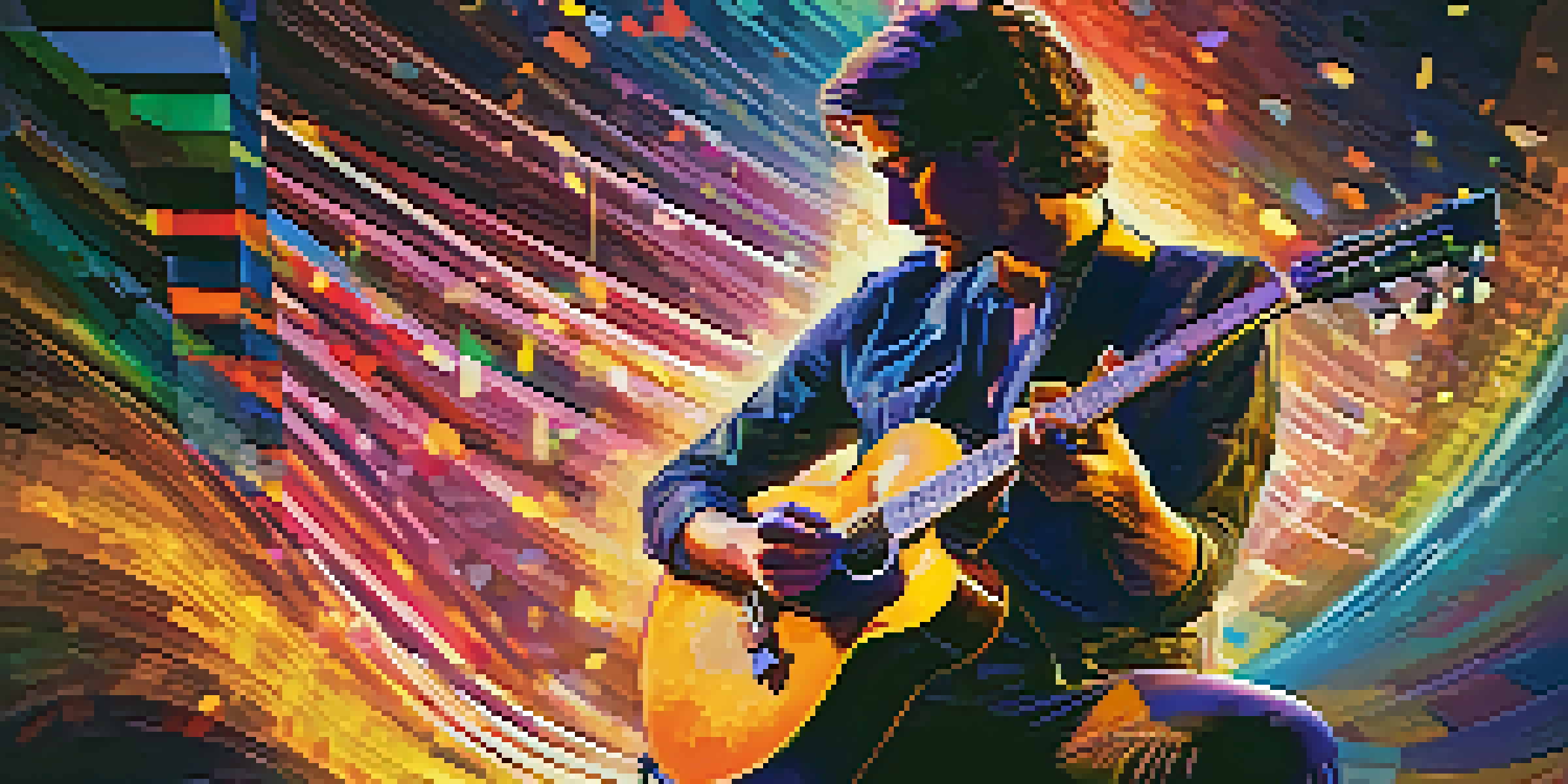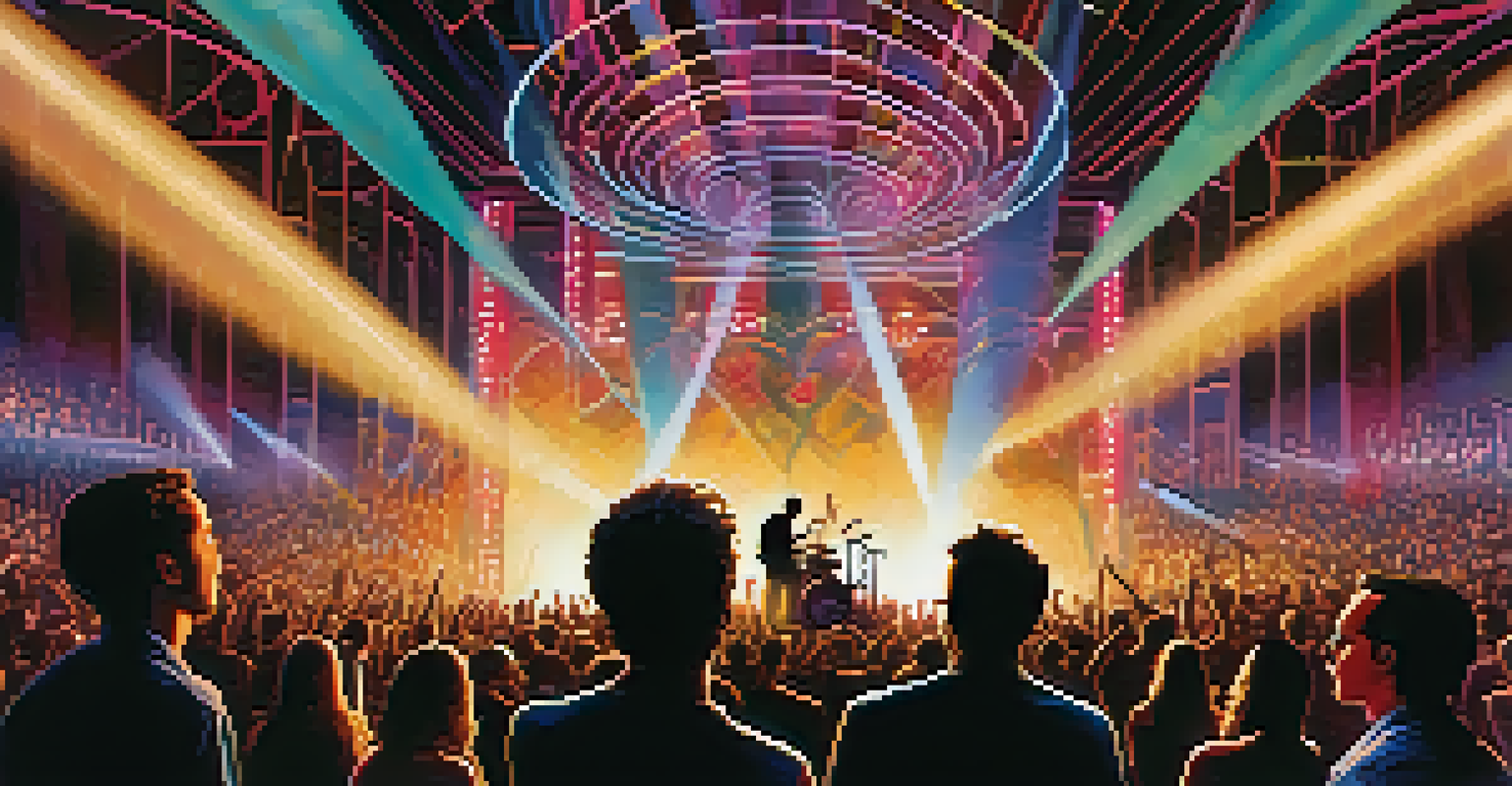Merging Guitar with Digital Art: A New Artistic Frontier

Exploring the Intersection of Guitar and Digital Art
The fusion of guitar music and digital art represents a vibrant new frontier for artists. This innovative blend allows musicians to visualize their sound in exciting new ways. Picture a guitarist strumming chords while vibrant digital imagery dances on a screen, synchronizing with the rhythm of the music. This synergy not only enhances the performance but creates a multi-sensory experience that captivates audiences.
Art is not freedom from discipline, but disciplined freedom.
Digital art has evolved tremendously, offering tools that empower artists to express their creativity like never before. For guitarists, these tools can transform simple melodies into immersive visual stories. With software programs and applications, musicians can manipulate visuals in real-time, creating an engaging atmosphere that resonates with their audience on multiple levels.
As this artistic collaboration grows, it opens doors for fresh expressions and innovative performances. Imagine a live concert where the guitar riffs are complemented by a stunning visual display that reflects the mood of the music. This intersection invites both musicians and digital artists to push boundaries, encouraging experimentation that enriches both fields.
The Role of Technology in This Artistic Fusion
Technology plays a crucial role in merging guitar with digital art, providing artists with unprecedented capabilities. Advanced software allows musicians to create visuals that respond directly to their guitar playing, offering a dynamic, interactive experience. This means that as the guitar riff changes, so do the visuals, creating an organic connection between the sound and sight.

Furthermore, the accessibility of technology has democratized this artistic fusion. With just a laptop and some creativity, aspiring artists can experiment with different styles, sounds, and visuals. This has led to an explosion of creativity, as more individuals find unique ways to express themselves through the combination of sound and imagery.
Artistry Meets Technology
The fusion of guitar music and digital art creates a captivating multi-sensory experience for audiences.
Moreover, platforms like social media have given rise to a community of artists sharing their work and collaborating across disciplines. Guitarists are now teaming up with digital artists, creating content that attracts a wider audience and inspires others to explore the possibilities of this merger.
Case Studies: Successful Collaborations
Several artists have successfully navigated the merging of guitar and digital art, creating compelling works that inspire others. For instance, guitarist Kaki King is renowned for her innovative performances that blend intricate guitar work with stunning visual projections. Her shows transform into a narrative experience where the visuals enhance the storytelling of the music.
The best way to predict the future is to create it.
Another example is the collaboration between bands like The Flaming Lips and visual artists, who have created psychedelic concert experiences that engage all senses. The integration of animated visuals with live guitar performances creates an immersive environment that leaves a lasting impression on audiences.
Such collaborations highlight how the merging of these two art forms can lead to groundbreaking performances. By sharing their unique talents, artists can craft experiences that not only entertain but also provoke thought and emotion, bridging the gap between sound and sight.
The Impact on Live Performances
The integration of digital art into live guitar performances has revolutionized the concert experience. Audiences are no longer just passive listeners; they are immersed in a multi-dimensional artistic journey. The combination of live music with real-time visuals creates a powerful atmosphere, enhancing the emotional connection between the performer and the audience.
This evolution has also prompted musicians to rethink their stage presence. Guitarists are now considering how their movements, sounds, and the accompanying visuals can work in harmony. This level of thoughtfulness ensures that every performance is unique, making each concert an unforgettable experience for attendees.
Challenges in Collaboration
Merging these art forms presents challenges, including the need for technical skills and ensuring visual coherence with musical intent.
As a result, venues are investing in better technology to accommodate these hybrid performances. The demand for state-of-the-art sound and visual equipment is on the rise, paving the way for a new standard in live music that blends artistry with cutting-edge technology.
Challenges in Merging Art Forms
Despite the exciting possibilities, merging guitar with digital art does come with its challenges. One significant hurdle is the technical knowledge required to effectively utilize digital tools. Musicians who may be adept on their instrument might find themselves facing a learning curve when it comes to mastering software and hardware needed for integration.
Additionally, there can be a disconnect between the artist's musical intent and the generated visuals. Ensuring that the visuals accurately reflect the emotions and themes of the music is crucial, and this balance can be tricky to achieve. Artists must communicate effectively with their digital collaborators to maintain coherence in their creative vision.
Finally, as with any artistic trend, there’s the risk of oversaturation. As more artists explore this fusion, it’s essential to maintain originality. Finding unique ways to stand out while still utilizing the tools of digital art will be key for artists looking to make a mark in this evolving landscape.
Future Trends: Where Are We Headed?
The future of merging guitar with digital art looks promising, with new trends emerging regularly. One notable direction is the rise of virtual and augmented reality experiences. These technologies allow audiences to engage with performances in entirely new ways, offering interactive elements that enhance the connection between the music and the visuals.
Moreover, as artificial intelligence continues to develop, its potential impact on music and art is enormous. Imagine AI-generated visuals that adapt in real-time to a guitarist's playing style, creating a truly personalized experience for both the artist and the audience. This innovative approach could redefine how we think about creativity and collaboration.
Future of Artistic Expression
Emerging technologies like virtual reality and AI are set to redefine the collaboration between guitarists and digital artists.
Additionally, educational institutions are beginning to recognize the importance of this fusion. By incorporating digital art into music programs, they are preparing the next generation of artists to embrace technology as a vital part of their creative toolkit. This forward-thinking approach ensures that the merging of these art forms will continue to evolve and inspire.
Conclusion: Embracing a New Artistic Era
Merging guitar with digital art is not just a trend; it signifies a new era in creative expression. This fusion encourages artists to explore and innovate, breaking traditional boundaries to discover new forms of storytelling. As technology continues to advance, the possibilities are endless, allowing for deeper connections between musicians and their audiences.
By embracing this new frontier, artists can craft experiences that resonate on multiple levels, enriching the cultural landscape. The collaboration between guitarists and digital artists is paving the way for a future where creativity knows no limits. Together, they are not only enhancing their art forms but also inspiring others to think outside the box.

As we look ahead, the excitement surrounding this merging of disciplines continues to grow. It invites everyone—musicians, digital artists, and audiences alike—to participate in a dynamic artistic journey that celebrates the beauty of creativity in its many forms.